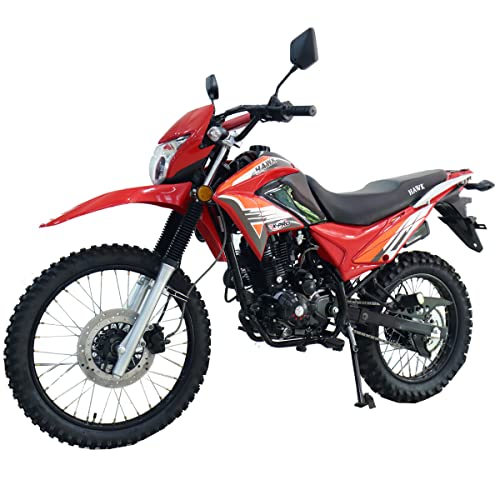When it comes to motorcycles, one crucial aspect is understanding the inner workings of their engines. The majority of motorcycle engines, just like their automobile counterparts, operate on a four-stroke cycle, also known as the Otto cycle. Understanding this cycle helps grasp the fundamental principles behind the combustion process of these engines.
Red X-Pro Hawk 250 Enduro Motorcycle
The ultimate thrill-seeking experience on the roads - conquer any terrain with the Red X-Pro Hawk 250 Enduro Motorcycle
Product information
Product Review Score
4.38 out of 5 stars
105 reviewsProduct links
The first stage is the intake stroke. During this stage, the intake valve opens, allowing the fuel-air mixture to enter the combustion chamber. The piston moves downwards, increasing the volume within the cylinder and creating a vacuum effect. This vacuum draws the fuel-air mixture into the chamber through the intake valve. Simultaneously, the piston compresses any remaining exhaust gases and sends them out through the exhaust valve.
The second stage is the compression stroke. Once the piston reaches its lowest position in the intake stroke, it starts ascending, compressing the fuel-air mixture that was drawn in during the previous stage. As the piston moves upward, it reduces the volume within the cylinder, thus increasing the pressure and temperature of the mixture. This elevated temperature and pressure prepare the mixture for the next stage - combustion.
X-PRO Hawk 250 Motorcycle with Accessories (Blue)
Discover the perfect motorcycle for your adventures - the X-PRO Hawk 250 with complete range of accessories, all in mesmerizing blue hue
Product information
Product Review Score
4.73 out of 5 stars
113 reviewsProduct links
The third stage is the power or combustion stroke. Here, when the piston reaches the top of its stroke, the spark plug ignites the highly compressed fuel-air mixture. The combustion causes a rapid expansion of gases, forcing the piston back down and generating the power that drives the motorcycle's output shaft. This stroke is the primary source of power in the four-stroke engine cycle.
The last stage is the exhaust stroke. As the piston nears the bottom of its power stroke, the exhaust valve opens, and the piston starts its ascent once again. This upward motion pushes the remaining combustion gases out through the exhaust valve. The cylinder is then cleared, ready to begin the next intake stroke and complete the four-stroke cycle.
Green X-PRO Hawk 250 Motorcycle
Shop the latest Green X-PRO Hawk 250 Motorcycle for an exhilarating off-road riding experience
Product information
Product Review Score
4.21 out of 5 stars
90 reviewsProduct links
Fuel, Spark, Power: Delving into Ignition and Combustion
The 4-stroke motorcycle engine is a fascinating piece of machinery, comprised of intricate components working together harmoniously to generate power. Among these components, the ignition and combustion system play a vital role in the engine's functioning. In this section, we will shed light on the inner workings of ignition and combustion, unraveling the mysteries that lie within.
Understanding Ignition
Ignition is the process that ignites the air-fuel mixture in the combustion chamber, starting the power stroke. It all begins by introducing a precisely measured mixture of fuel and air into the combustion chamber. The spark plug, a small but critical component, provides the necessary spark to ignite this mixture at the right moment. It does so by creating an electric arc across its gap, which ignites the compressed air-fuel mixture and initiates the combustion process.
Delving into Combustion
Once ignited, the air-fuel mixture undergoes rapid combustion, releasing energy in the form of expanding gases that drive the piston downward and power the engine. This process typically occurs in a fraction of a second, but it is a tightly controlled sequence of events. The combustion can be divided into several stages, including the ignition delay, flame propagation, and burnout phase. Each stage plays a crucial role in ensuring efficient and reliable operation, with countless factors influencing the timing and quality of the combustion process.
The Significance of Timing and Fuel Quality
Timing and fuel quality are two essential factors that directly impact the ignition and combustion process. The precise timing of the spark is crucial to achieve optimum engine performance. Advanced engine management systems are employed to control the timing, ensuring it occurs at the right moment as dictated by various operating conditions. Additionally, the quality and composition of the fuel greatly affect combustion. Premium fuels with the appropriate octane rating are essential to prevent premature detonation, as well as to maximize power output and minimize engine knocking.
Timing is Everything: Exploring the Role of Valves
The smooth and efficient operation of a 4-stroke motorcycle engine relies on the precise timing and coordination of various internal components, with valves playing a crucial role in this intricate process. Valves act as gateways that allow the mixture of fuel and air to enter the combustion chamber and the exhaust gases to exit. Understanding the timing and function of valves can provide insights into how these impressive machines generate power and propel riders on the open road.
Intake Valves: Opening the Door to Power
The intake valves play a critical role in the first step of the engine cycle, known as the intake stroke. As the piston moves downward, creating a vacuum within the combustion chamber, the intake valves open to allow the fuel-air mixture to enter. The timing of the valve opening is carefully controlled by the camshaft, which rotates in sync with the engine's crankshaft. Optimal timing ensures maximum efficiency and power output, allowing the engine to intake the perfect amount of fuel-air mixture for combustion.
Exhaust Valves: Clearing the Path
The exhaust valves are responsible for expelling the combustion by-products from the engine during the exhaust stroke. Similar to the intake valves, the timing of the exhaust valves is crucial. As the piston moves upward during this stroke, the exhaust valves open to release the burnt gases. Proper timing ensures that the valves open at the right moment to maximize the expulsion of exhaust gases and minimize resistance in the engine, optimizing performance and fuel efficiency.
Valve Timing: A Balancing Act
The precise timing of both the intake and exhaust valves is vital for the engine to operate smoothly. The camshaft, connected to the crankshaft through a chain or belt, determines this timing. Variations in the camshaft's shape and the positioning of lobes, along with the use of mechanical or hydraulic valve lifters, affect valve timing and duration. Engineers carefully design these components to achieve the desired performance characteristics of the engine, balancing factors such as power, efficiency, and emissions control.
X-PRO Hawk 250 Enduro Motorcycle (Black)
Experience the adrenaline rush with the X-PRO Hawk 250 Enduro Motorcycle in sleek black design
Product information
Product Review Score
4.7 out of 5 stars
84 reviewsProduct links
Efficiency and Exhaust: Decoding Gears and Automotive Systems
When it comes to understanding the inner workings of 4-stroke motorcycle engines, efficiency and exhaust are two crucial aspects to consider. Gears play a fundamental role in optimizing efficiency while ensuring the engine operates smoothly. By decoding the functionality of gears and automotive systems, riders can gain a deeper understanding of how their machines operate.
Gears are essentially a series of toothed wheels that transfer power from the engine to the wheels, allowing the motorcycle to move forward. They enable the engine to operate at its most efficient RPM range, ensuring power is effectively transmitted to the wheels. Gears work in tandem with the engine's torque and speed characteristics, allowing riders to maximize acceleration and control. Understanding the gear ratios and how they relate to the engine's RPM will enable riders to make informed decisions while riding, such as when to shift gears for optimal performance.
Another crucial aspect of automotive systems is the exhaust system. It plays a vital role in improving the performance of 4-stroke motorcycle engines. The exhaust system works by guiding the flow of exhaust gases out of the engine, reducing backpressure, and allowing the engine to breathe more efficiently. This enables the engine to produce more power and torque, resulting in enhanced performance. Furthermore, a well-designed exhaust system can also contribute to a more pleasing and distinctive engine sound, a characteristic highly valued by motorcycle enthusiasts.




